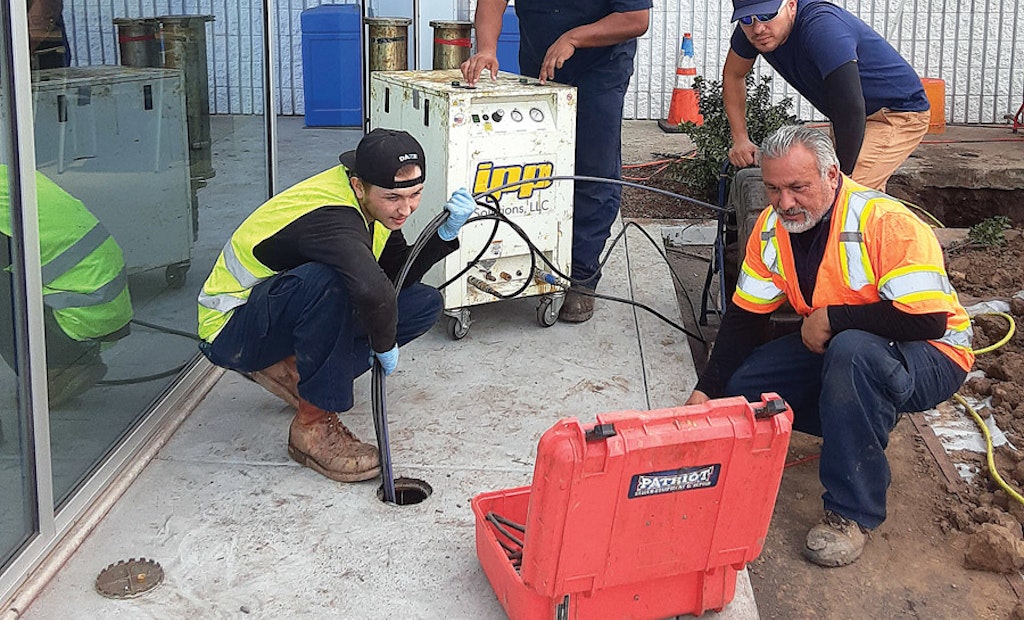Interested in Relining/Rehab?
Get Relining/Rehab articles, news and videos right in your inbox! Sign up now.
Relining/Rehab + Get AlertsLining vertical runs of pipes inside buildings, particularly high-rise structures, is often problematic due to access issues with bulky pipe lining equipment. And then there’s the matter of reinstating all those branch lines, a laborious and time-consuming task.
But Tom Hlavac, the co-owner of California-based Select Trenchless Pipelines, sidesteps both of those issues with a PipeCaster Pro pipe coating system built by IPP Solutions. The investment has opened up a lucrative new market for the company, located in Riverside — about 55 miles east of downtown Los Angeles.
“There’s no question this machine has given us access to customers we couldn’t serve before, especially high-rise buildings,” says Hlavac, who co-owns the business with his son, Tom Hlavac Jr. “It allows us to fix customers’ problems without tearing out walls or ripping up concrete-slab floors.
“It makes life good for them and good for me, because the cost of pipe coating relative to opening up walls and floors is so much lower, but still profitable. It’s a win-win for clients and contractors. And not having to do reinstatements is absolutely a time-saver.”
The company, which Hlavac established in 2002 and employs 18 people, enjoys a broad customer base that includes residential, commercial, industrial and municipal clients. The most popular application for the technology is rehabbing leaking cast iron pipes.
With a price tag of around $35,000, which Hlavac says includes all the “bells and whistles,” the machine represents a considerable upfront investment. But the return on that investment has been substantial, he says.
“It definitely paid for itself. And it did so quickly, too.”
Ready, set, spray
Hlavac says operating the system is relatively easy, as long as operators get proper training, which IPP Solutions provides. He says that a competent technician should feel comfortable running the machine after two to three jobs.
The system sprays — not brushes — a two-part polyurea resin onto a pipe’s interior. (It also can dispense polyurethane and epoxy products.) The resulting coating is seamless, flexible and strong.
As with many pipeline rehab technologies, a clean host pipe is essential to a successful end product. Most of the pipe rehab projects Select Trenchless performs involve rusted-out cast iron pipes, so the first step is descaling those pipes.
“We do a very careful and controlled cleaning in order to preserve as much of the cast iron pipe as possible,” he explains.
To do that, Hlavac’s crews first use pipeline inspection cameras made by RIDGID and General Pipe Cleaners. Then they deploy drain machines such as Mini and Maxi Millers from Picote Solutions or a Little Wizard from GI Industries, along with chain-knockers made by Picote, GI Industries and Renssi Finland Oy.
The last step is a thorough cleaning with a dolly-mounted Patriot 1776 water jetter made by Patriot Sewer Equipment.
“You absolutely have to flush and clean the pipe with a water jetter to remove any oils from the pipes,” he explains. “Otherwise the coating won’t adhere properly.”
The last step is the actual coating process. An operator pours the two polyurea resin components into the unit, which mixes them at the correct proportions. Then a spinning sprayer mechanism attached to a neoprene hose gets fed all the way to the end of the host pipe. The actual coating process occurs as the hose is manually pulled back toward the operator.
“We slide a camera down the pipe after the sprayer is inserted, and pull it back along with the sprayer, so we can see how the coating is being applied,” Hlavac says. “Spraying on the coating is better than brushing it on because it gives you an even, consistent coat.”
The unit applies a coat that’s about 1/16-inch thick and cures in about 90 seconds. After that, more coats can be applied as needed.
“But two or three passes usually does the trick,” he says. “We can usually do about 5 feet per minute.”
The process requires two technicians, one to handle the camera and the other to apply the coating.
In one job, where the bottom of a 4-inch-diameter, 60-foot long cast iron pipe was completely rotted out, a technician applied the coating without spinning the sprayer head. “So the resin just squeezed out like toothpaste and filled in the rotted-out channel,” he says.
Seeing is believing
It’s not unusual for customers to be skeptical about the pipe coating technology. To boost their confidence, Hlavac shows them a section of commercially available, pre-coated cast iron pipe, available at most home centers.
“When people see that cast iron pipes actually are made with a coating, it gives the coating process credibility,” he says.
Investing in the PipeCaster Pro reflects Hlavac’s overall philosophy of staying at the forefront of technology in order to best serve customers.
“When new, cutting-edge technology comes along, it’s incumbent on us as plumbing professionals to know what’s out there so we can present it as a solution for our clients. You’ve got to keep up with the times.”
Hlavac also says it’s important to thoroughly vet new products to be sure they provide great solutions for customers. If he doesn’t believe in a certain technology, he refuses to offer it to clients.
Educating customers also is an important part of the sales process, particularly for newer technology like pipe coating, he adds.
“After I educate customers about the process and show them a sample of a coated pipe, I get approvals pretty quickly. It’s a no-brainer option that sells itself — and then some.”






